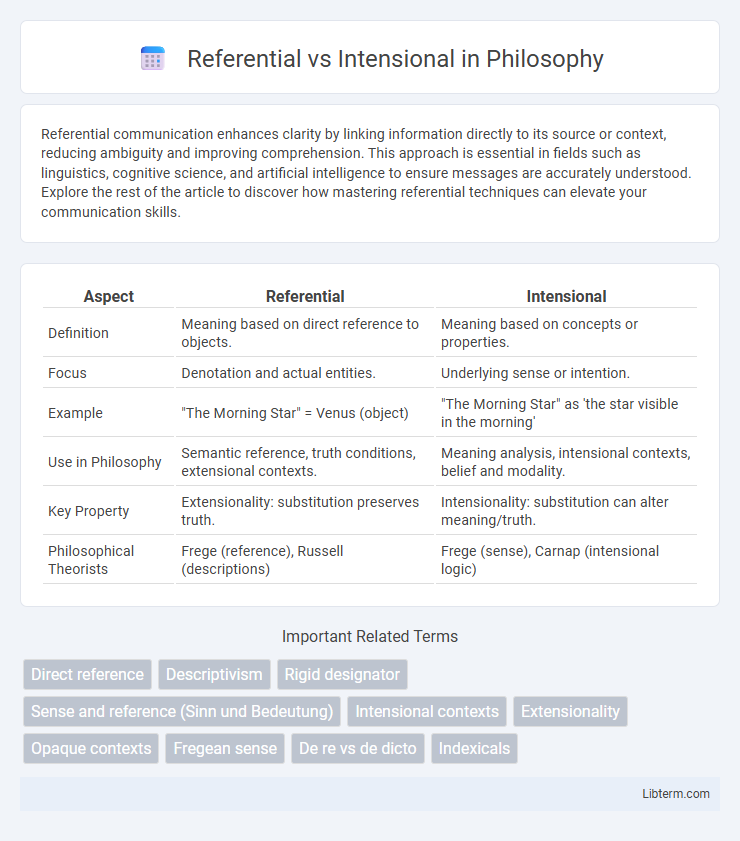Referential communication enhances clarity by linking information directly to its source or context, reducing ambiguity and improving comprehension. This approach is essential in fields such as linguistics, cognitive science, and artificial intelligence to ensure messages are accurately understood. Explore the rest of the article to discover how mastering referential techniques can elevate your communication skills.
Table of Comparison
| Aspect | Referential | Intensional |
|---|---|---|
| Definition | Meaning based on direct reference to objects. | Meaning based on concepts or properties. |
| Focus | Denotation and actual entities. | Underlying sense or intention. |
| Example | "The Morning Star" = Venus (object) | "The Morning Star" as 'the star visible in the morning' |
| Use in Philosophy | Semantic reference, truth conditions, extensional contexts. | Meaning analysis, intensional contexts, belief and modality. |
| Key Property | Extensionality: substitution preserves truth. | Intensionality: substitution can alter meaning/truth. |
| Philosophical Theorists | Frege (reference), Russell (descriptions) | Frege (sense), Carnap (intensional logic) |
Introduction to Referential and Intensional Approaches
Referential approaches focus on the relationship between language expressions and their actual objects or entities in the real world, emphasizing direct reference and truth conditions. Intensional approaches analyze meanings based on possible worlds and contexts, addressing how the sense or concept of an expression varies with interpretation. This distinction is fundamental in semantics, influencing how meaning is modeled in linguistics and logic.
Defining Referential Semantics
Referential semantics centers on the relationship between linguistic expressions and their actual entities or objects in the real world, emphasizing precise identification and truth conditions. It defines meaning through reference, whereby each term corresponds to a specific object or set of objects, enabling clear and consistent interpretation. This contrasts with intensional semantics, which focuses on the internal content or concept associated with expressions rather than their direct real-world referents.
Understanding Intensional Semantics
Intensional semantics analyzes meaning based on possible worlds and contexts, capturing the truth conditions of statements beyond mere reference. It addresses the way expressions convey meaning through concepts and properties that may vary across different scenarios, unlike referential semantics which focuses solely on the actual entities referred to. Understanding intensional semantics is essential in natural language processing and formal logic for handling modal expressions, belief reports, and propositional attitudes effectively.
Key Differences Between Referential and Intensional Meaning
Referential meaning specifically denotes the actual object or entity that a word or phrase corresponds to in the real world, focusing on tangible or identifiable references. Intensional meaning encompasses the concepts, properties, or inherent attributes associated with a term, highlighting its sense or the internal content that defines its reference. Key differences include that referential meaning is about denotation and factual reference, while intensional meaning involves the idea or quality that determines which entities fall under the term.
Real-World Examples of Referential Expressions
Referential expressions in language directly point to specific real-world entities, such as "Barack Obama" referring to the 44th President of the United States, while intensional expressions focus on concepts or properties without specifying a particular object, like "the current President." Real-world examples include proper names, definite descriptions, and demonstratives that uniquely identify individuals or objects in a given context. Understanding the distinction enhances clarity in communication, information retrieval, and natural language processing by accurately linking language to its intended real-world referents.
Use Cases for Intensional Contexts
Intensional contexts occur in scenarios involving belief, knowledge, or necessity, where the truth value depends on the mode of presentation rather than the actual reference. These contexts are critical in natural language processing, especially in tasks like machine translation and sentiment analysis, where understanding the speaker's intention or belief is essential. Use cases include modeling propositional attitudes in AI, handling non-extensional operators in formal semantics, and developing systems for context-aware information retrieval.
Referential vs Intensional in Natural Language Processing
Referential semantics in Natural Language Processing (NLP) deals with the direct relationship between linguistic expressions and real-world entities, enabling accurate entity recognition and coreference resolution. Intensional semantics focuses on the context-dependent meanings and concepts underlying expressions, crucial for tasks like word sense disambiguation and intent detection. Balancing referential and intensional approaches enhances NLP models by improving both the understanding of concrete references and the interpretation of nuanced, context-driven meanings.
Challenges in Distinguishing Referential and Intensional Meanings
Distinguishing referential from intensional meanings poses challenges due to the subtle nuances between an expression's direct referent and the properties or concepts it conveys. Referential meaning hinges on identifying the exact entity a term points to in the real world, while intensional meaning involves the inherent attributes or conditions defining the term within a given context. Ambiguities often arise in natural language processing and semantic analysis when contexts shift or when expressions lack clear referential grounding, complicating accurate interpretation and leading to potential misunderstandings or misrepresentations in communication.
Impact on Linguistics and Philosophy
Referential and intensional approaches significantly shape linguistic semantics and philosophical theories of meaning by distinguishing how expressions relate to objects and concepts. Referential semantics emphasizes the direct relationship between linguistic expressions and concrete entities, essential for understanding truth conditions and communication accuracy. Intensional semantics focuses on the mental representations or concepts behind expressions, influencing theories on modality, belief, and the interpretation of context-dependent language.
Conclusion: Choosing Between Referential and Intensional Analysis
Referential analysis provides clarity by focusing on the actual entities a term denotes, crucial for applications requiring precise identification such as database management and semantic web technologies. Intensional analysis emphasizes the conceptual content or properties associated with terms, benefiting areas like natural language understanding and knowledge representation where context and meaning are paramount. Choosing between referential and intensional analysis depends on whether the priority lies in concrete identification or in capturing the underlying semantic properties of expressions.
Referential Infographic

 libterm.com
libterm.com